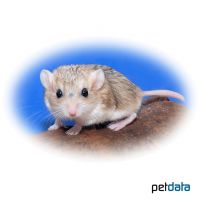Fat-tailed Gerbil (Pachyuromys duprasi)
| Fat-tailed Gerbil Pachyuromys duprasi | |
|---|---|
| Name | Fat-tailed Gerbil |
| Name Lat. | Pachyuromys duprasi |
| Family | Murids |
| Family lat. | Muridae |
| Order | Rodents |
| Order lat. | Rodentia |
| Origin | Africa |
| Climate | Subtropical |
| Habitat | Semi-desert, savanna |
| Diet | Seeds, plant matter, hay, insects |
| Behavior | Nocturnal |
| Keeping | Pair, group |
| Care Level | Moderate |
| Life Span | 4-7 years |
| Protection | No |
| Metric Units | |
| Size | 10-14 cm |
| Temperature | Room temperature |
| Housing | A: 0.5 m² / H: 50-60 cm |
| US Units | |
| Size | 3.9"-5.5" |
| Temperature | Room temperature |
| Housing | 5 ft² / 20" hight |
Distribution and habitat
The range of the crepuscular and nocturnal fat-tailed gerbils is the northern edge of the Algerian Sahara to southwestern Egypt. They inhabit self-dug burrows in sparsely vegetated dry savannas and semi-deserts.
Maintenance
Minimum dimensions for the enclosure:
| 1-2 animals | area: 0,5 m² | height: 50-60 cm |
| Each additional animal | Area: + 20 |
A terrarium placed in a bright (no direct sunlight), draught-free and quiet place is recommended, with ventilation openings on the sides, and it must not be tightly closed at the top
The enclosure should be structured with rocks, roots, and branches, and provide hiding and shelter (rodent houses, tubes, clay caves, etc.). They need food and drinking containers (drinking bottles), a sand bath (chinchilla sand) for grooming, nesting material (hay, straw, etc.) and a substrate for digging. Commercially available small animal litter or a sand-peat mixture covered with some bark mulch, dry leaves, hay and straw is suitable as a substrate. The bedding depth should be at least 10 cm, better 20 cm. Nail material, such as untreated twigs and branches of fruit trees, as well as a rodent stone, must always be available to wear down their teeth. They should be kept at room temperature and their natural day-night rhythm should be respected.
Diet
Their diet is mainly vegetarian, but they also need animal protein. The diet consists of a low-fat grain mixture, available in specialized shops as "gerbil food", supplemented with forage hay, cob millet, some green food (root vegetables, wild herbs, zucchini, etc.) and a mineral stone. In addition, they need animal protein, such as live insects (crickets, house crickets, mealybug larvae), cottage cheese, a hard-boiled hen's egg or insect food for hedgehogs. Fruit must be offered infrequently and in very small quantities. Water must always be available in hanging bottles or in stable, open containers and, like food, must be offered fresh daily
A varied diet promotes health and prevents deficiency symptoms.
Behaviour and compatibility
In the wild, they live in loose colonies with fixed territories. They should be kept in a family group or same-sex group with adequate retreats. At the first signs of incompatibility, the animals should be separated immediately.
Reproduction and breeding
In the male, the anal and genital openings are farther apart than in the female.
The gestation period is 20-22 days. A litter usually consists of 2-5 young. They are born naked and blind and are independent after about 29 days. Males can reach sexual maturity as early as 2 months of age, while females do not become sexually mature until 3-6 months of age. Females may give birth up to 3 times per year. Their life expectancy can be up to 7 years.
Important
They sleep through most of the day, often stretched out on their backs. If disturbed while sleeping, it takes up to half a minute for them to respond. They store fat reserves in their tails for times when food and water are scarce.
To prevent their very fine fur from becoming greasy, they need sufficient sandy areas. It has been proven to cover one part of the enclosure with litter and the other part with a mixture of bird and chinchilla sand.
They should not be grabbed or pulled by the tail, as the skin can easily crack and come off. The animals should only be grasped by hand from below and lifted up. Special attention should be paid to thorough hygiene and impurities should be removed regularly.
Further literature can be found in your pet store.
References
Text: petdata; Image: petdata
Source: W. PUSCHMANN, D. ZSCHEILE, K. ZSCHEILE (2009): Zootierhaltung - Tiere in menschlicher Obhut: Säugetiere, Harri Deutsch Verlag; GRZIMEK (2000): Grzimeks Tierleben Bd. 2 Säugertiere, Kindler Verlag; BMEL (2014): Gutachten über Mindestanforderungen an die Haltung von Säugetieren
- Gemäß § 21 Abs. 5 Tierschutzgesetz idgF
